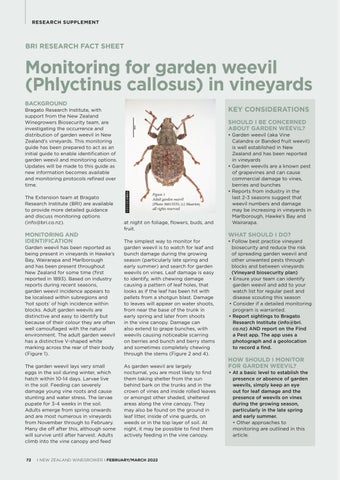RESEARCH SUPPLEMENT
BRI RESEARCH FACT SHEET
Monitoring for garden weevil (Phlyctinus callosus) in vineyards BACKGROUND
KEY CONSIDERATIONS
Bragato Research Institute, with support from the New Zealand Winegrowers Biosecurity team, are investigating the occurrence and distribution of garden weevil in New Zealand’s vineyards. This monitoring guide has been prepared to act as an initial guide to enable identification of garden weevil and monitoring options. Updates will be made to this guide as new information becomes available and monitoring protocols refined over time. The Extension team at Bragato Research Institute (BRI) are available to provide more detailed guidance and discuss monitoring options (info@bri.co.nz).
MONITORING AND IDENTIFICATION
Garden weevil has been reported as being present in vineyards in Hawke’s Bay, Wairarapa and Marlborough and has been present throughout New Zealand for some time (first reported in 1893). Based on industry reports during recent seasons, garden weevil incidence appears to be localised within subregions and ‘hot spots’ of high incidence within blocks. Adult garden weevils are distinctive and easy to identify but because of their colour they are often well camouflaged with the natural environment. The adult garden weevil has a distinctive V-shaped white marking across the rear of their body (Figure 1). The garden weevil lays very small eggs in the soil during winter, which hatch within 10-14 days. Larvae live in the soil. Feeding can severely damage young vine roots and cause stunting and water stress. The larvae pupate for 3-4 weeks in the soil. Adults emerge from spring onwards and are most numerous in vineyards from November through to February. Many die off after this, although some will survive until after harvest. Adults climb into the vine canopy and feed
72
SHOULD I BE CONCERNED ABOUT GARDEN WEEVIL?
Figure 1 Adult garden weevil (Photo 36013555, (c) Maarten, all rights reserved
at night on foliage, flowers, buds, and fruit. The simplest way to monitor for garden weevil is to watch for leaf and bunch damage during the growing season (particularly late spring and early summer) and search for garden weevils on vines. Leaf damage is easy to identify, with chewing damage causing a pattern of leaf holes, that looks as if the leaf has been hit with pellets from a shotgun blast. Damage to leaves will appear on water shoots, from near the base of the trunk in early spring and later from shoots in the vine canopy. Damage can also extend to grape bunches, with weevils causing noticeable scarring on berries and bunch and berry stems and sometimes completely chewing through the stems (Figure 2 and 4). As garden weevil are largely nocturnal, you are most likely to find them taking shelter from the sun behind bark on the trunks and in the crown of vines and inside rolled leaves or amongst other shaded, sheltered areas along the vine canopy. They may also be found on the ground in leaf litter, inside of vine guards, on weeds or in the top layer of soil. At night, it may be possible to find them actively feeding in the vine canopy.
I NEW ZEALAND WINEGROWER I FEBRUARY/MARCH 2022
• Garden weevil (aka Vine Calandra or Banded fruit weevil) is well established in New Zealand and has been reported in vineyards • Garden weevils are a known pest of grapevines and can cause commercial damage to vines, berries and bunches • Reports from industry in the last 2-3 seasons suggest that weevil numbers and damage may be increasing in vineyards in Marlborough, Hawke’s Bay and Wairarapa.
WHAT SHOULD I DO?
• Follow best practice vineyard biosecurity and reduce the risk of spreading garden weevil and other unwanted pests through blocks and between vineyards (Vineyard biosecurity plan) • Ensure your team can identify garden weevil and add to your watch list for regular pest and disease scouting this season • Consider if a detailed monitoring program is warranted. • Report sightings to Bragato Research Institute (info@bri. co.nz) AND report on the Find a Pest app. The app uses a photograph and a geolocation to record a find.
HOW SHOULD I MONITOR FOR GARDEN WEEVIL? • At a basic level to establish the presence or absence of garden weevils, simply keep an eye out for leaf damage and the presence of weevils on vines during the growing season, particularly in the late spring and early summer. • Other approaches to monitoring are outlined in this article.
